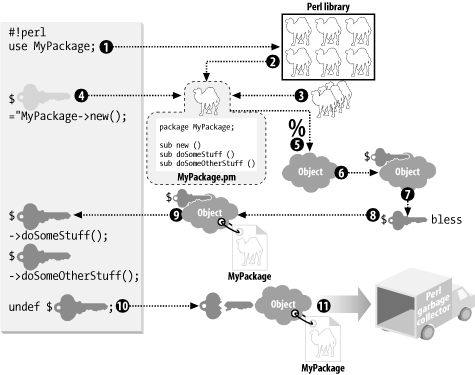Perl's Object Orientation
So far,
we've covered the whole of basic Perl in fewer than
20 pages (Perl purists will be horrified at how much
we've skipped over!) Now we're
ready to engage hyper-drive and head toward Perl's
object orientation zone.
Packages
In
order to provide the Holy Grail of code reusability, Perl provides
plenty of scope for the creation of software packages. These packages
are generally held in a Perl module file, such as
MyPackage.pm, which can be accessed from a main
script like this:
use MyPackage;
A basic package skeleton can look as simple as this:
package MyPackage;
use strict;
sub doSomeStuff { # Some subroutine code here }
sub doSomeOtherStuff { # Some other subroutine code here }
To create our package, all we needed to do was name it and create
some methods. And that was it.
Bless this Object
To go
beyond packages and into object territory, we use the wizardry of the
bless command. We'll extend our
earlier skeleton and make it into a real class by adding a
new constructor containing this most magical of
commands:
package MyPackage;
use strict;
sub new {
my($class) = @_;
my $self = {}; # Anonymous hash! :-)
bless $self, $class;
return $self;
}
sub doSomeStuff { # Some subroutine code here }
sub doSomeOtherStuff { # Some other subroutine code here }
There's an awful lot going on within those few lines
of code in the new method.
We've broken it down into 11 life-cycle steps,
listed below and illustrated in Figure A-6.

To initiate the life cycle we call the use
MyPackage command to import the package from the Perl
library.
The package imports into memory and stands ready for action. If it were a more complex package, MyPackage
could multiply inherit from other objects in the Perl library.
The new method is called in the main script,
requesting that a key be returned to a brand new object generated by
the packaged class constructor:
$key = MyPackage->new( ); As we've seen, this new method
contains the following code:
my($class) = @_;
my $self = {};
bless $self, $class;
return $selfWhen the arrow notation is used with a package name to call a method,
such as new, the package name gets sent
automatically into the method as the first parameter of the special
@_ subroutine parameter array. We take this
string
`MyPackage'
and assign it to the $class scalar variable. We
then create an anonymous hash with the {}
notation. This effectively becomes the object
for the rest of the life cycle, and is used later to store important
object state information.
We take a reference key to this anonymous hash object and store it in
the lexically scoped $self variable:
my $self = {};The magical bless command now associates the
object with the class name:
bless $self, $class; With the class name firmly labeled to the object, the referential key
is returned to the calling program. The anonymous hash will continue
to exist as long as at least one reference is
pointing to it:
return $self; The program can now use the returned key to drill down to the
object's class and call its various methods to do
useful work.
The calling program eventually undefines the key or lets it go out of
scope.
With a reference count of zero, the original object has become a
bubble of memory entirely disconnected from the outside world.
Because it's of no more use to anyone, it is quickly
gobbled up by Perl's garbage memory collector. The
object's life cycle is complete.
After this lightning tour of basic Perl, we're now
ready to start using Perl's object-oriented packages
with confidence, including Perl DBI (whose features are summarized in
Appendix B).
|



